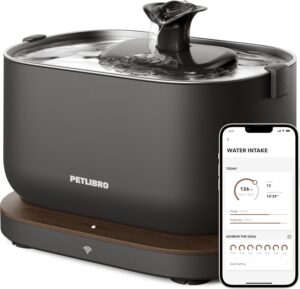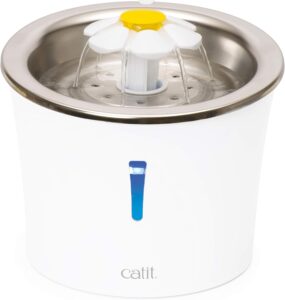My cat Charlie barely touched his water bowl. Every morning, same thing. Full bowl, untouched water.
Then I noticed something. When I turned on the bathroom faucet, he’d come running. He wanted fresh, flowing water. Not stagnant bowl water that had been sitting for hours.
That’s when I discovered smart pet water fountains. These aren’t your grandma’s water bowls. They monitor hydration levels. They alert you when water’s low. Some even separate clean water from wastewater.
After testing five different models with Charlie and my rescue dog Luna, I found the fountains that actually make a difference. Let me show you which ones keep your pets hydrated and healthy.
Quick Pick: Our #1 Recommendation
PETLIBRO Dockstream Smart Fountain
This fountain changed everything. The app tracks exactly how much water Charlie drinks. It sends alerts to my phone when the water’s low. And the stainless steel tray prevents the chin acne Charlie used to get from plastic bowls.
The wireless pump design makes refilling effortless. No tangled cords. No wrestling with wires during cleaning.
Best For: Pet owners who want detailed health monitoring and app control
1. PETLIBRO Dockstream Smart Fountain

Best For: Comprehensive health monitoring with app connectivity
I’ll be honest. I thought the app tracking was gimmicky. Until Charlie’s drinking habits suddenly changed and the app alerted me. Turns out he had a UTI. The vet said catching it early made all the difference.
The PawSense Health Monitoring System records every sip. You see daily reports, weekly trends, and can set custom hydration goals. The 2.5L capacity means fewer refills for busy schedules.
Specs:
- App-controlled with 2.4GHz Wi-Fi connectivity
- 23dB ultra-quiet operation (quieter than a whisper)
- Wireless pump for easy cleaning and refilling
Pros:
- Real-time water level alerts sent to your phone
- Filter change reminders keep maintenance on track
- Emergency 130ml storage during power outages
2. Potaroma Smart Wireless Pet Water Fountain

Best For: Budget-conscious owners who want smart features without breaking the bank
What sold me on the Potaroma: no filters needed. Ever. That’s hundreds of dollars saved over the fountain’s lifetime.
The wastewater separation system is genius. Clean water stays clean. Hair and saliva go into a separate waste tank. Your pet never drinks recycled dirty water.
Specs:
- 3.5L large capacity (lasts 3-9 days between refills)
- 180-day battery life on a single charge
- Dual-tank system separates clean and wastewater
Pros:
- Cordless design lets you place it anywhere
- No replacement filters means low ongoing costs
- Almost silent operation (perfect for light sleepers)
3. Catit Flower Fountain Stainless Steel

Best For: Cats with whisker sensitivity and picky drinking preferences
Charlie hated his old fountain. The opening was too narrow. His whiskers touched the sides every time he drank. Then I got the Catit Flower Fountain.
The wide, shallow drinking surface means zero whisker stress. And the three water flow settings let you find what your cat prefers. Charlie likes the gentle bubbling top. Luna prefers the streaming flower mode.
Specs:
- 3L capacity with water level indicator window
- Triple Action filtration (cotton mesh, carbon, ion exchange)
- Dishwasher-safe stainless steel top
Pros:
- LED nightlight for visibility in the dark
- Ergonomic design prevents whisker fatigue
- BPA-free materials safe for sensitive pets
4. UTOPPI Smart Wireless Cat Water Fountain

Best For: Multi-room homes needing portable hydration stations
I keep one UTOPPI fountain downstairs and another in the bedroom. No cords means I can move them wherever the pets hang out.
The self-cleaning feature automatically tips wastewater. Less maintenance for me. Fresher water for the pets. The rechargeable battery lasts for months.
Specs:
- 3L capacity with easy snap-on assembly
- Built-in rechargeable battery (cordless operation)
- No filter design for simple maintenance
Pros:
- Compact and lightweight for easy portability
- Dual tank system keeps water fresh
- Touch screen for easy time and volume settings
5. Veken Stainless Steel Cat Water Fountain

Best For: Multi-pet households on a budget
My neighbor has three cats. She needed something affordable that could handle multiple drinkers. The Veken delivers.
The 95oz capacity with a large reserve tank means her cats always have water. The 5-stage filtration keeps it clean despite heavy use. And at under $40, it’s the best value for multi-pet families.
Specs:
- 95oz/2.8L large capacity water tank
- 5-stage advanced filtration system
- LED light feature with on/off option
Pros:
- Innovation Award Winner for design excellence
- BPA-free construction for pet safety
- Optional LED light helps pets find water at night
Considerations When Buying a Smart Pet Water Dispenser
Smart Features You Actually Need
Not all “smart” features are useful. Focus on what matters:
Essential Features:
- Water level monitoring (so you never forget to refill)
- Filter change reminders (keeps water clean)
- Drinking habit tracking (catches health issues early)
Nice-to-Have Features:
- Multiple flow modes (for picky drinkers)
- App connectivity (for data nerds like me)
- Power outage backup (peace of mind during storms)
Skip gimmicks like motion sensors that activate every time your cat walks by. They drain battery and startle nervous pets.
Material Matters More Than You Think
I learned this the hard way. Charlie developed chin acne from plastic fountains. Switched to stainless steel. Problem solved.
Stainless Steel: Hygienic, dishwasher-safe, prevents bacteria buildup. Best for cats prone to chin acne.
BPA-Free Plastic: Lighter, cheaper, easier to see water level. Fine for most pets.
Ceramic: Heavy, stable, looks great. But harder to clean and more breakable.
Filtration Systems Aren’t All Equal
Some fountains use triple filtration. Others skip filters entirely. Both work.
Multi-stage filtration: Removes hair, debris, heavy metals, and odors. Replace filters every 2-4 weeks. Ongoing cost: $30-50/year.
Filter-free systems: Use wastewater separation instead. No ongoing costs. Just rinse and refill.
I prefer filter-free for convenience. But if your tap water tastes terrible, filtration helps.
Capacity Depends on Your Situation
Don’t just guess. Calculate it.
Cats need about 4 ounces of water per 5 pounds of body weight daily. Dogs need more.
My 10-pound cat Charlie: Needs 8 ounces daily. A 2L fountain lasts 8-10 days.
My 40-pound dog Luna: Needs 32+ ounces daily. Same fountain lasts 2-3 days.
For multiple pets, get at least 3L capacity. Or get two smaller fountains in different rooms.
Noise Level Changes Everything
My first fountain sounded like a tiny waterfall. Peaceful, right? Wrong. It kept me up all night.
Look for fountains under 25dB. That’s quieter than a whisper. The PETLIBRO Dockstream runs at 23dB. I literally can’t hear it.
Avoid fountains with loud pumps or splashing water. Your sleep matters.
Cleaning Frequency Reality Check
Every fountain needs regular cleaning. Period. The question is how much of a pain it is.
Easy to clean: Wireless pumps, dishwasher-safe parts, wide openings, few crevices.
Pain to clean: Wired pumps, hand-wash only, narrow tubes, lots of small parts.
I clean Charlie’s fountain weekly. Takes 5 minutes with the wireless pump. My old fountain with wired pump? 20 minutes of frustration.
App Connectivity Trade-offs
Apps sound cool. But they require Wi-Fi. And another login to remember. And permission to send notifications.
Get an app-connected fountain if:
- You travel frequently and want peace of mind
- Your pet has health issues requiring monitoring
- You’re tracking multiple pets’ habits
Skip the app if:
- You’re home most days
- You prefer simple, reliable tech
- You don’t want another device on your Wi-Fi network
I use the app. My neighbor doesn’t. We’re both happy with our choices.
Battery vs. Corded Power
Cordless fountains offer placement freedom. Corded fountains never run out of power.
Battery-powered: Place anywhere. Take it traveling. Lasts 30-180 days per charge. Risk of forgetting to charge.
Corded: Unlimited runtime. Never dies unexpectedly. Limited by outlet location.
I keep a corded fountain in the main room (where there’s an outlet) and a battery fountain in the bedroom.
Conclusion
The best smart pet water dispenser isn’t about fancy technology. It’s about solving your specific problem.
If you want comprehensive health tracking and money’s no object, the PETLIBRO Dockstream is unmatched. If you need filter-free convenience that saves money long-term, grab the Potaroma Smart Wireless. And if you have a picky cat with whisker sensitivity, the Catit Flower Fountain is your answer.
I spent years fighting Charlie’s dehydration. Now he drinks 40% more water. His vet notices the difference. So do I.
Your pet deserves fresh, flowing water. You deserve a fountain that doesn’t require a PhD to operate.
The right fountain is on this list. The question is: which problem are you solving?
FAQ
Q: Do smart water fountains really encourage pets to drink more?
A: Yes, according to both research and my experience. Moving water attracts cats and dogs better than still water. Charlie’s water intake increased by 40% after switching. The sound and movement trigger their natural preference for fresh-flowing water sources.
Q: How often do I need to clean a smart pet fountain?
A: Clean it weekly for best results. The actual cleaning takes 5-10 minutes with wireless pump models. Daily quick rinse of the bowl helps. Replace filters every 2-4 weeks if your model uses them. Neglecting cleaning leads to biofilm buildup and sick pets.
Q: Are app-connected fountains worth the extra cost?
A: Only if you’ll actually use the features. I check Charlie’s hydration data daily because he’s had UTI issues. For healthy pets with attentive owners home often, a basic smart fountain works fine. The app paid for itself when it caught Charlie’s illness early.
Q: Can I use a smart fountain for both cats and dogs?
A: Depends on the size. Small dogs and cats share fountains well. Large dogs need bigger capacity fountains (3L minimum) or they’ll drain it in a day. My 10-pound cat and 40-pound dog share a 3L fountain, but I refill it every 2-3 days.
Q: What happens if the power goes out?
A: Battery-powered fountains keep running. Corded fountains stop. Many smart fountains like the PETLIBRO have emergency water storage (130-170ml) that stays accessible. But invest in a battery backup or have a backup bowl ready for extended outages.
Q: Do stainless steel fountains really prevent chin acne?
A: Yes, dramatically. Plastic harbors bacteria even after washing. Bacteria cause feline acne. Charlie had constant breakouts with plastic bowls. Switched to stainless steel. Breakouts stopped within 2 weeks. Vets recommend stainless steel or ceramic for this reason.
Q: How accurate is the hydration tracking?
A: Very accurate in single-pet households. The PETLIBRO tracks within 5-10ml using a built-in scale. Multi-pet households get total consumption but can’t distinguish between pets (unless you get the RFID collar version). Good enough to spot concerning changes.
Q: Are filter-free fountains as clean as filtered ones?
A: Different approaches, both work. Filtered fountains capture more microscopic particles. Filter-free fountains with wastewater separation keep fresh water from mixing with contaminated water. I prefer filter-free for convenience and cost savings. Both keep water cleaner than a bowl.
Q: What’s the quietest smart pet fountain?
A: PETLIBRO Dockstream at 23dB. For comparison, a whisper is 30dB. Most quality fountains run under 30dB. Avoid fountains over 40dB—they’re annoyingly loud. Check reviews for noise complaints before buying. Pumps get louder as they age, so quiet operation matters.
Q: Can I take a smart fountain when traveling?
A: Battery-powered fountains travel well. Cordless models like the Potaroma or UTOPPI work anywhere. Empty before travel, reassemble at your destination. Corded fountains need outlets, limiting placement options. I take my battery fountain on weekend trips. Charlie drinks normally away from home.
